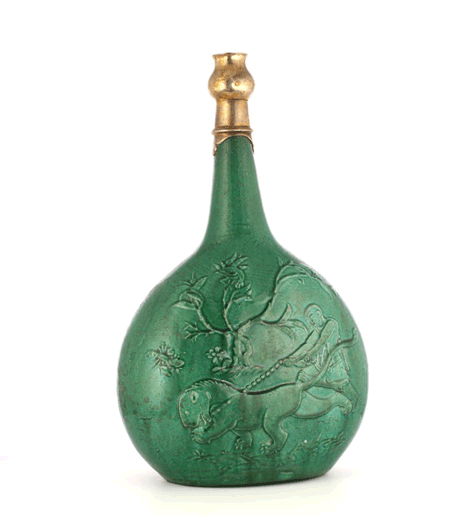Click on the image to zoom
Green bottle with moulded scene of lion and tamer
- Accession Number:AKM732
- Place:Iran, Isfahan(?)
- Dimensions:Height: 37 cm
- Date:ca. 1630
- Materials and Technique:stonepaste body; later silver neck and mouth replacement; mould-formed with moulded decoration, glazed
Among ceramics produced during Iran’s Safavid period (1501–1722), monochrome moulded wares with very well-drawn figural scenes and floral and arabesque patterns constitute a remarkable group of closed forms. These include bottles of ovoid or rectangular section, qaliyans (water-pipes), and flasks. In this opaque green bottle from the Aga Khan Museum Collection, the draftsmanship of its figural scenes has been executed at a level worthy of the most renowned painter of the time, Reza-i ‘Abbasi (ca. 1565–1635). The bottle’s graceful shape was produced by pressing clay (stonepaste) into a two-part mould, one scene in each part, and then putting them together. The seam where they join is still discernable.
Further Reading
On one side of the bottle, a man struggles to restrain a lion. On the other side, two mythological beasts cavort in a landscape. The lion tamer wears the costume of a hunter—a long-sleeved jacket with trousers tucked into his boots and a quiver slung over his back. The lion’s curving body and long sinuous tail contrast with the straight line formed by the taut rope and outstretched arms of the straining hunter. The two beasts on the reverse side are a qilin (below) and a zebu (above, humped cattle). The qilin was a Chinese mythological beast, an omen of good luck.
The theme of man struggling with a ferocious beast, such as a lion, has a long history in Persian art going back to ancient times, as seen in the stone carvings of the Achaemenid palace at Persepolis (ca. 520 BCE). The struggle was a metaphor for the power of the ruler, and the lion retained this meaning in Islamic art. Although hunting was still a popular royal pastime in the Safavid period in Iran, as shown in paintings, the scene on the bottle most likely depicts a captive lion from the royal menagerie. The man is not a princely figure but most probably the game-keeper, capturing a beast that had escaped from the grounds.
This theme appears elsewhere in Safavid art. Sadiqi Bek (d. 1612) had drawn a scene similar to the one appearing on the bottle (Art Institute of Chicago, 1987.360.5), but it is evident from the collar with bell that the lion belonged to the royal menagerie. From time to time such beasts did escape, and the tragedy resulting from the escape of a tiger was depicted by the painter Mu‘in Musavvir in 1672. [1] Apparently, during the reign of Shah Abbas, a lion escaped from a game park and encountered a gathering. The incident was recorded in a wall painting and on tiles, [2] such as those of the Chehil Sutun and Hasht Behesht palaces in Isfahan.
While the mythological beasts appearing on the reverse of the bottle also have roots in the ancient past (such as the bull attacking the gazelle at Persepolis), the immediate inspiration came from China. At this time Chinese goods—silks, lacquer objects, but especially blue-and-white porcelain—were sought after and collected. The Chinese qilin had a dragon-like head, antlers, and cloven hooves, and was often enflamed.
At least four more moulded bottles bearing the two scenes described here are known. [3] The theme of hunting appears on another series of moulded bottles, but the details are painted in blue and white. There are nearly two dozen bottles with the same theme of a hunter aiming a matchlock rifle at deer, although the bottles are not all from the same mould. [4]
— Lisa Golombek
Notes
[1] Boston, MFA, no. 14.634. Mu‘in Musavvir also painted a lion and tamer; see Robert Eng, “MOʿIN-E MOṢAVVER,” Encyclopædia Iranica, online edition, 2016
[2] M. Farhad, “An Artist’s Impression: Muʿin Musavvir’s Tiger Attacking a Youth,” Muqarnas 9 (1992): 122. ISBN: 9789004096257
[3] L. Golombek, R.B. Mason, P. Proctor, and E. Reilly, Persian Pottery in the First Global Age: the Sixteenth and Seventeenth Centuries (Leiden: Brill, 2014), 88–89.
[4[ L. Golombek, “A Safavid Bottle with Matchlock Hunt in the Royal Ontario Museum.” In New Perspectives on Safavid Iran: Empire and Society, ed. C.P. Mitchell (New York: Routledge, 2011), 123–39.
References
Boston, MFA, no. 14.634. Mu‘in Musavvir also painted a lion and tamer; see Robert Eng, “MOʿIN-E MOṢAVVER,” Encyclopædia Iranica, online edition, 2016.
M. Farhad, “An Artist’s Impression: Muʿin Musavvir’s Tiger Attacking a Youth,” Muqarnas 9, 1992. ISBN: 9789004096257
L. Golombek, R.B. Mason, P. Proctor, and E. Reilly, Persian Pottery in the First Global Age: the Sixteenth and Seventeenth Centuries. Leiden: Brill, 2014. ISBN: 9789004260856
L. Golombek, “A Safavid Bottle with Matchlock Hunt in the Royal Ontario Museum.” In New Perspectives on Safavid Iran: Empire and Society, ed. C.P. Mitchell. (New York: Routledge, 2011. ISBN: 9780415774628
Note: This online resource is reviewed and updated on an ongoing basis. We are committed to improving this information and will revise and update knowledge about this object as it becomes available.




